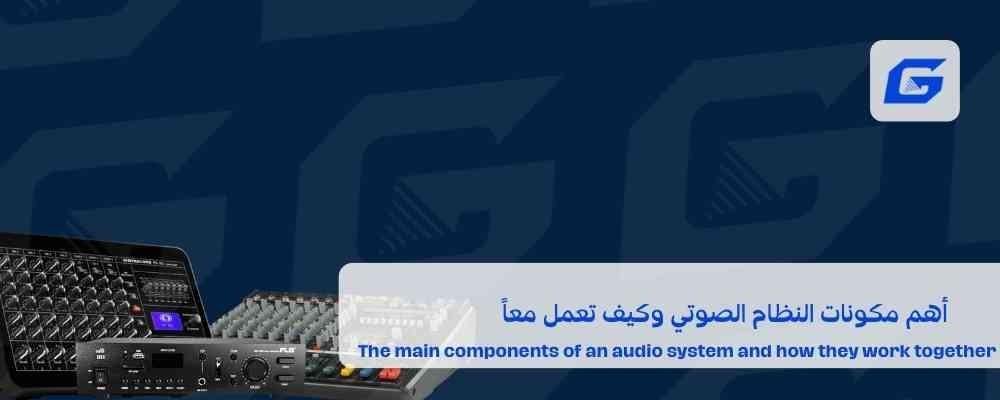In the world of audio systems, whether it’s for live events, professional studios, or even home use, there are several essential components that work together harmoniously to achieve the best audio performance . From speakers to audio processors , each component has a specific role, and their integration together is what ensures clear, balanced sound. In this article, we’ll learn about the most important components of an audio system and how they each work together to ensure an optimal listening experience.
1. Speakers
Speakers are the essential component of any audio system, converting electrical signals into sound waves that we can hear. There are several types of speakers, such as active speakers and passive speakers , and each works in a different way.
How do speakers work?
- Loudspeakers contain a speaker that converts the electrical signal into mechanical movement (vibrations) in the vocal membrane .
- These vibrations produce sound waves that travel through the air and reach the human ear.
Tip to improve speaker performance:
- Make sure to choose speakers that are appropriate for the size of the room and the type of event to get the best sound distribution .
2. Mixer
The mixer is one of the most important components in advanced audio systems, as it mixes and organizes audio signals coming from different sources (such as microphones and musical instruments ). The mixer allows the user to adjust the volume, balance , and various sound effects .
How does a mixer work?
- A mixer combines audio signals from multiple sources, such as microphones and musical instruments , and then sends these signals to speakers or recording systems .
- The mixer has control knobs to adjust volume levels , balance between different channels, and apply audio effects such as reverb or echo .
Advice for choosing a mixer:
- Choose a multi-channel mixer with sound effects if you're managing large events or professional music productions .
3. Audio Processor
An audio processor is an essential part of improving sound quality, as it modifies and changes audio signals before sending them to the speakers. This includes frequency adjustment , balance , and echo cancellation , thus helping to improve sound clarity and reduce noise .
How does a sound processor work?
- The audio processor filters high and low frequencies as needed, and enhances sound balance to ensure each frequency is evenly distributed.
- A sound processor is also used to reduce noise and interference, such as whistling or whispering, that may be distracting during presentations.
Advice for using the sound processor:
- Adjust the processor periodically during events to ensure there is no audio distortion , making sure to maintain audio clarity at all frequencies.
4. Microphones
Microphones are the means by which sound is captured and converted into an electrical signal that can be processed and amplified by the audio system. Microphones vary in types and uses, such as dynamic microphones and condenser microphones .
How do microphones work?
- Microphones convert sound waves into an electrical signal , which is then sent to a mixer or audio processor to begin the processing and amplification process.
- In large sound systems, microphones are strategically placed to pick up sound from multiple sources .
Microphone selection advice:
- Choose a microphone that's appropriate for the type of sound you want to capture, such as a wireless microphone for live events or a condenser microphone for precise vocal recordings.
5. Amplifier
An amplifier is a device that amplifies the electrical signal coming from an audio processor or mixer to make it strong enough to drive speakers. Without an amplifier, the audio signal would not be strong enough to produce audible sound.
How does a magnifier work?
- An amplifier amplifies weak audio signals coming from microphones or musical instruments to strong levels that can produce sound from speakers.
- Active amplifiers have a built-in amplifier , while passive amplifiers require an external amplifier .
Advice for choosing a speaker:
- Make sure to choose an amplifier that matches the size of your speakers , so that it can provide the necessary power without affecting the sound quality .
6. Cables and Connectors
Wires and connectors are essential components that ensure proper connection between all components of an audio system. Each component of an audio system needs a certain type of connector to ensure efficient transmission of the audio signal .
How do wires and connectors work?
- Wires are used to transmit the signal from microphones or music equipment to the mixer or audio processor , and then to the speakers .
- The wires must be of high quality to ensure signal transmission without distortion or sound leakage .
Advice for choosing wires:
- Use durable wires and high-quality connectors to ensure clear audio signal transmission and reduce noise or interference.
conclusion
Every component of an audio system works together in harmony to ensure an optimal audio experience. From the speakers that convert the signal into sound waves , to the mixer that mixes those signals, to the audio processor that enhances the quality, each part plays a crucial role. By choosing the right components and installing them correctly, you can significantly improve the sound quality in any environment.
Post Cover Description
A case showing the components of the audio system such as microphones , speakers and mixer on a workbench with wires and connectors connected to them, reflecting the integration between these components to achieve the best audio experience .

